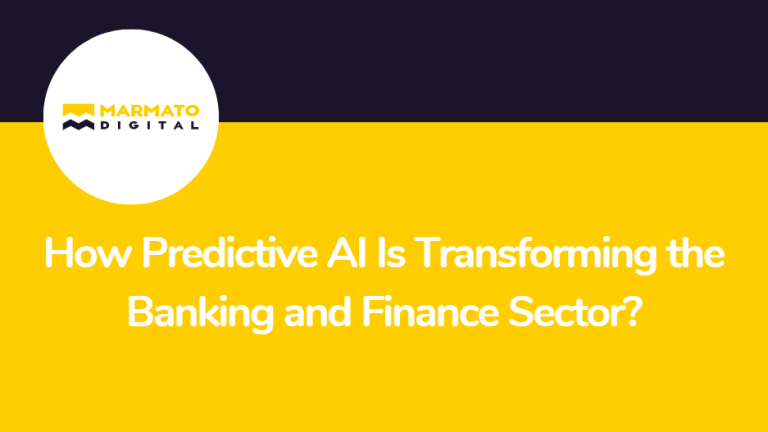The banking and finance industry is changing fast. What used to be a face-to-face, paperwork-heavy experience is now mostly digital. From mobile apps to online loan approvals, customers expect quick, smooth, and personalized service, just like they get from top e-commerce or streaming platforms.
To keep up, banks and financial institutions are turning to AI. One area gaining major traction is predictive AI. This advanced technology helps businesses make smarter decisions by using data to predict what might happen next.

Why Predictive AI Matters in Banking and Finance?
Banks and financial institutions handle huge volumes of customer data every day, including transaction histories, loan applications, account behavior, and more. But data alone doesn’t create value. What truly matters is turning that data into actionable insights.
That’s where predictive AI comes in.
Predictive AI uses smart algorithms to analyze past data and forecast future behavior. It can help your team understand trends, customer needs, and risks before they happen. For CMOs, this means the ability to build more targeted campaigns, improve customer journeys, and support revenue growth.
At a high level, predictive AI enables:
- Better decisions – from product recommendations to customer targeting.
- Faster actions – like responding instantly to fraud or churn signals.
- Stronger experiences – through personalized, data-backed communication.
In a competitive industry where speed and trust matter, using predictive AI can set your bank apart.
Key Use Cases of Predictive AI in the Banking Sector:
a. Fraud Detection:
Fraud is a major concern in banking. Traditional systems can be slow or trigger too many false alarms.
With predictive AI, you can:
- Spot unusual or suspicious behavior in real time.
- Reduce false positives by learning customer patterns over time.
- Alert customers quickly and reduce potential losses.
For marketing leaders, this means improved brand trust and customer satisfaction.
b. Credit Risk Scoring:
Knowing whether someone is likely to repay a loan is critical, but traditional credit scores don’t always tell the full story.
Predictive AI can:
- Analyze a broader set of data like income patterns, spending habits, and social signals.
- Create more accurate and fair credit risk scores.
- Help grow lending to underserved or newer customer segments.
This supports marketing goals around inclusion, innovation, and customer growth.
c. Customer Retention and Engagement:
Customers today expect banks to understand them and stay one step ahead.
Predictive AI helps you:
- Identify early signs of customer churn.
- Predict when customers might be ready for a new service (e.g., mortgage, credit card).
- Deliver timely, personalized messages that keep them engaged.
This empowers your team to build loyalty campaigns that feel timely and relevant.
d. Investment and Portfolio Management:
Whether for individual investors or wealth clients, AI can help advisors make better decisions.
Predictive AI enables:
- Smarter forecasting of market trends and asset performance.
- Customized portfolio recommendations based on a client’s risk profile.
- Quicker reactions to market shifts.
As a CMO, this gives you new stories to tell about innovation, accuracy, and client success.
e. Loan Approval Automation:
Loan applications can take days or even weeks. Predictive AI speeds things up.
It can:
- Analyze applications in real-time using a broader set of risk indicators.
- Recommend approvals or rejections faster and more accurately.
- Lower the cost of manual processing and reduce human error.
This leads to happier customers, faster onboarding, and higher conversion rates, three wins for any marketing team.
Benefits of Predictive AI for Banks and Customers:
Predictive AI doesn’t just help IT or data teams; it delivers clear value across marketing, sales, operations, and the entire customer journey. As a CMO, here’s how it can impact both your brand and bottom line:
- Faster, Smarter Decision-Making: Predictive AI helps your teams act quickly and with more confidence. From campaign timing to product recommendations, decisions are backed by data, not guesswork. This leads to better results and fewer missed opportunities.
- Better Risk Management: Whether it’s detecting fraud, predicting loan defaults, or spotting early signs of churn, predictive AI gives you a head start. It allows your teams to be proactive instead of reactive, protecting both revenue and reputation.
- More Personalized Customer Experiences: AI helps tailor experiences across channels, email, mobile, web, and in-branch. You can send the right message at the right time, offer relevant products, and guide customers based on their actual behavior. This builds loyalty and trust.
- Cost Savings and Improved Efficiency: Predictive AI automates time-consuming tasks like lead scoring, customer segmentation, and risk analysis. This saves your team valuable hours, reduces manual errors, and helps allocate budgets more effectively.
Challenges to Consider:
While the benefits are big, there are a few important challenges to keep in mind before diving in.
- Data Quality and Privacy Concerns:
Predictive AI is only as good as the data behind it. Inaccurate or incomplete data can lead to poor decisions. And with sensitive financial data involved, privacy and security must always come first.
- Need for Regulatory Compliance:
The finance industry has strict rules, from GDPR to local banking laws. Any AI solution must align with these regulations and be able to explain how its decisions are made (known as “AI transparency”).
- AI Bias and Ethical Concerns:
AI models can unintentionally favor or exclude certain groups if they’re trained on biased data. It’s important to test your models regularly and build ethical oversight into your AI processes.
How Banks Can Get Started with Predictive AI?
You don’t need to overhaul your systems overnight. Starting small, learning fast, and scaling smartly is key. Here’s how to begin:
- Build a Clean and Secure Data Foundation:
Start by organizing your customer data across channels. Make sure it’s accurate, secure, and accessible; this is the base of any successful AI program.
- Start with One Use Case and Test Results:
Pick a high-impact area, like churn prediction or credit risk scoring. Launch a small pilot, measure the results, and use those learnings to grow adoption.
- Partner with AI Experts or Platforms:
AI moves fast. Consider working with vendors who understand the finance industry and offer proven solutions. Look for partners who can customize models to your needs and ensure compliance.
- Ensure Compliance with Finance Regulations:
Before launching any predictive AI project, involve your legal and compliance teams. Choose tools that offer explainability and audit trails to meet regulatory standards.
Unlock the Power of Predictive AI in Finance!
Subscribe to Newsletter
Get our latest blogs directly to your inbox.

